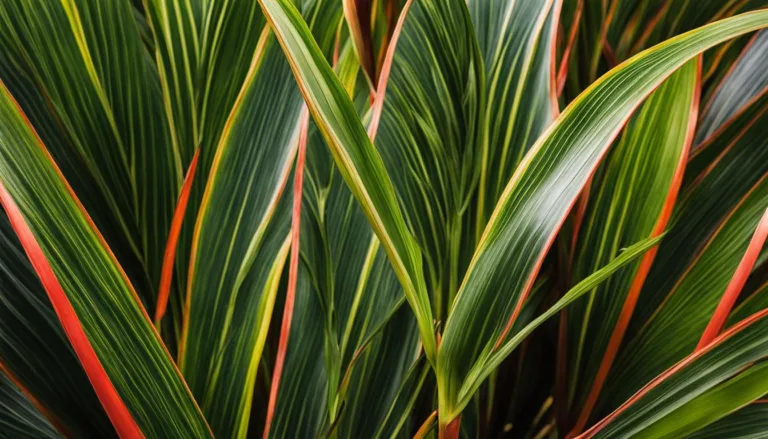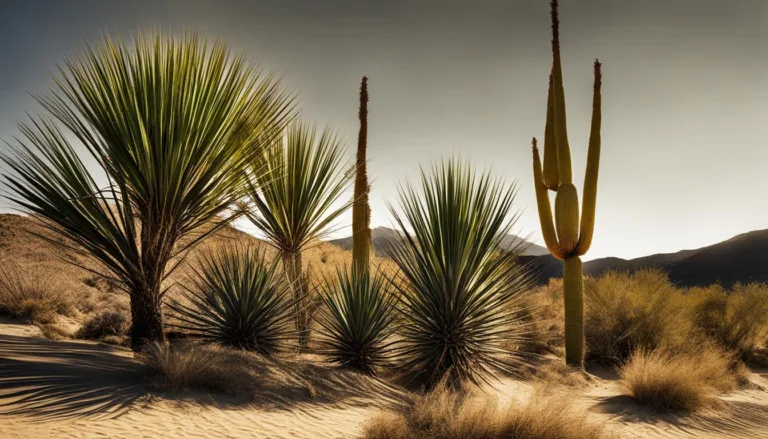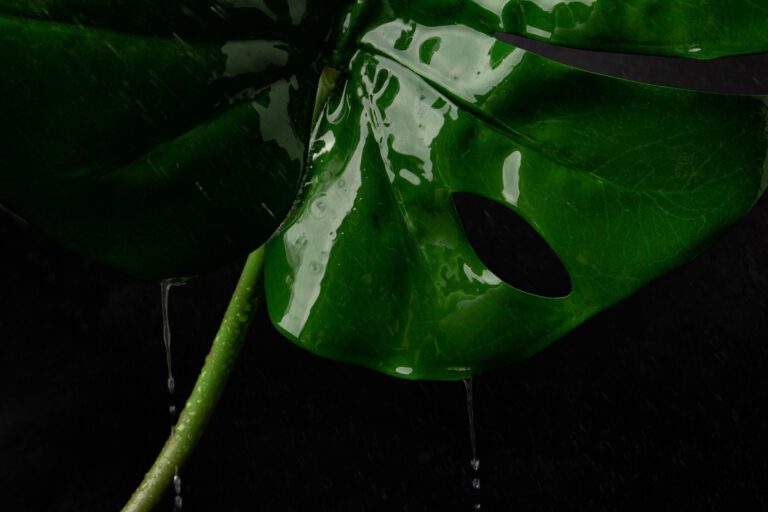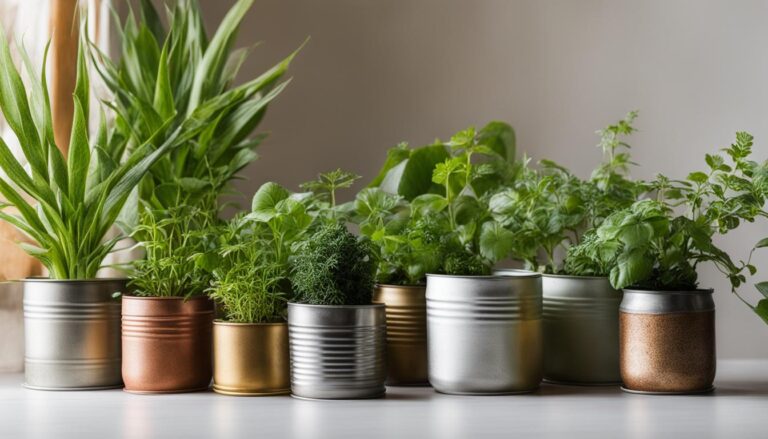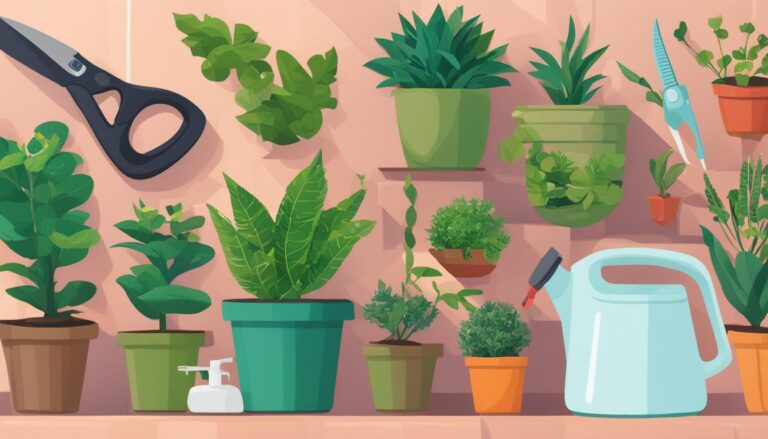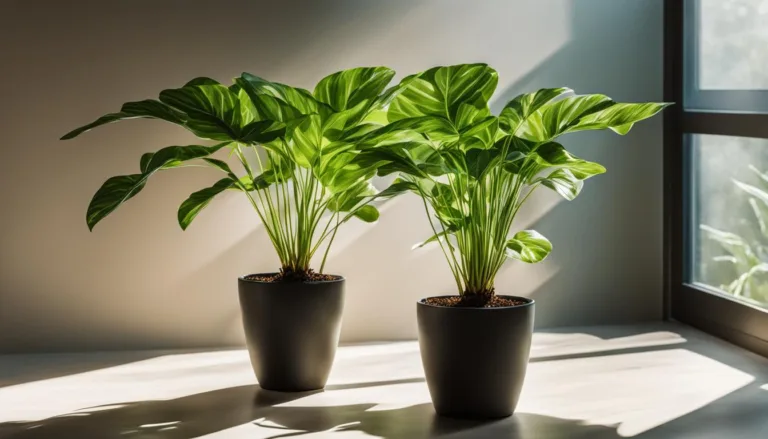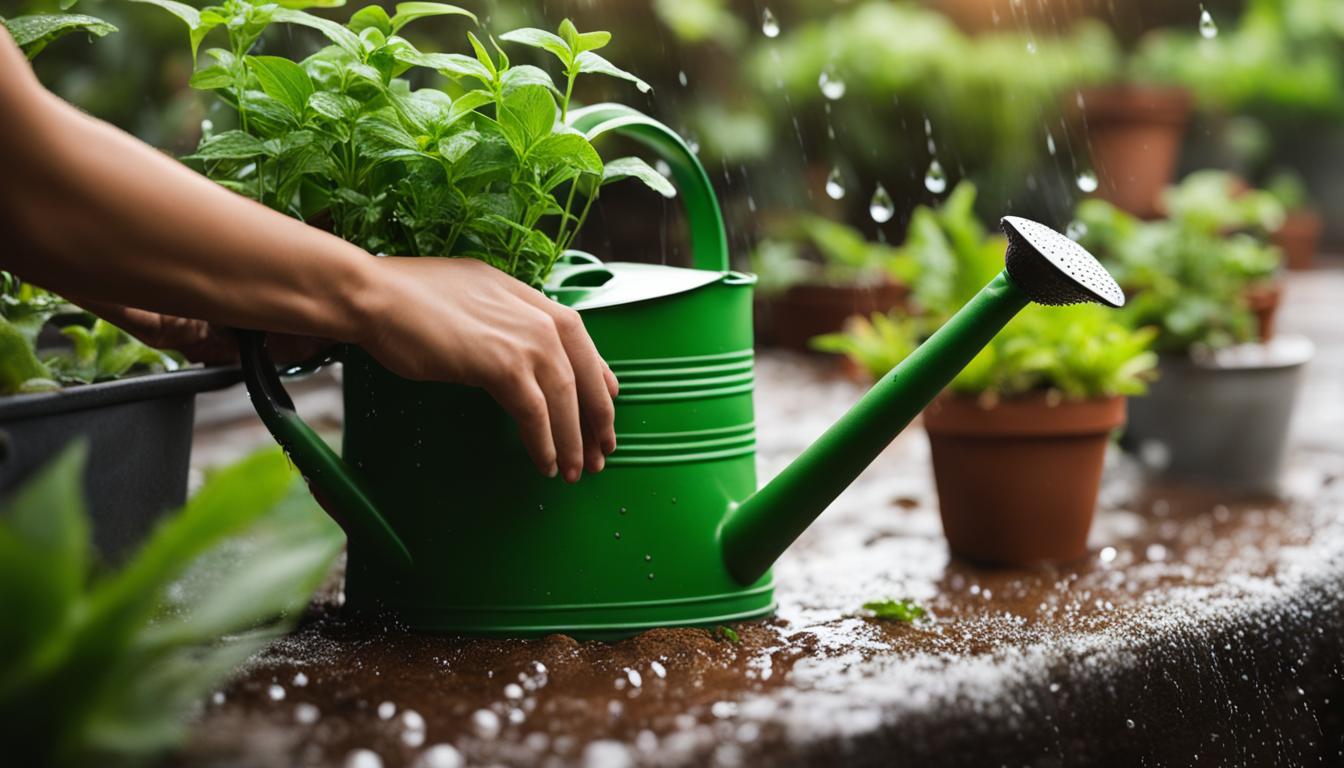
Are you planning a vacation but worried about leaving your beloved indoor plants behind? Don’t fret! With a little preparation and these helpful tips, you can keep your leafy companions healthy and happy while you’re away.
Whether it’s a short weekend getaway or an extended trip abroad, taking care of your indoor plants during travel doesn’t have to be a daunting task. By making a few adjustments and implementing some smart techniques, you can ensure that your plants thrive in your absence.
So, before you pack your bags and head out the door, take a moment to learn how to care for your indoor plants during travel. Your plants will thank you for it!
Key Takeaways:
- Properly adjust light and temperature to prevent wilting and dehydration.
- Maintain moisture by watering your plants before leaving and using water retention techniques.
- Avoid fertilizing your plants before travel to conserve energy and water.
- Prune your plants to remove dead foliage and buds or flowers that require frequent watering.
- Implement various watering techniques such as the water wicking method or DIY drip system.
Adjust Light and Temperature
When it comes to caring for your indoor plants while you’re away, adjusting the light and temperature is crucial to their well-being. By tweaking their environment, you can prevent overexposure to sunlight and ensure the right conditions for their growth.
First, consider the placement of your plants in relation to light sources. If your plants receive direct sunlight, it’s important to increase the distance between them and the light source to prevent wilting and damage. This can be done by moving them to a slightly shadier spot or using sheer curtains to filter the light.
Additionally, be mindful of the temperature in the room where your plants are located. Avoid placing them near air conditioning or heating systems, as these can deplete the humidity that tropical plants require. Maintaining a consistent temperature and humidity level will help your plants thrive in your absence.
Avoiding Air Conditioning
Air conditioning can significantly impact the humidity levels in your home, especially during hot summer months. As plants rely on a certain level of humidity to survive, it’s best to keep them away from air conditioning vents or units. This will help maintain the moisture they need to stay healthy and vibrant.
Maintain Moisture
Proper watering is crucial to keeping your indoor plants healthy while you’re away. Here are some effective techniques to help maintain moisture levels in the soil:
- Watering before travel: Before leaving for your trip, make sure to water your plants thoroughly. This will provide them with enough moisture to last for a week while you’re away.
- Watering frequency: Consider the length of your trip when determining how often to water your plants before leaving. For longer vacations, you can use water retention techniques to help prolong the moisture in the soil.
- Water retention techniques: There are several methods you can use to retain moisture in the soil. Adding mulch or rocks to the top layer of soil can help prevent evaporation and retain moisture. Another option is to create a self-watering system using capillary wicks or empty bottles.
- Asking a friend for help: If you have a friend or neighbor who can stop by and water your plants while you’re away, this can be a great solution. Make sure to provide them with clear instructions on how to water each plant and any specific watering requirements.
By implementing these techniques, you can ensure that your indoor plants stay hydrated and healthy even when you’re not there to care for them.
| Watering Technique | Description |
|---|---|
| Watering before travel | Thoroughly water your plants before leaving for your trip to provide them with enough moisture to last. |
| Watering frequency | Consider the length of your trip and adjust the watering frequency accordingly. Use water retention techniques for longer vacations. |
| Water retention techniques | Add mulch or rocks to retain moisture in the soil, or create a self-watering system using capillary wicks or empty bottles. |
| Asking a friend for help | If possible, ask a friend or neighbor to water your plants while you’re away. Provide clear instructions on watering and any specific requirements. |
Using these methods, you can ensure that your plants receive the proper moisture they need to thrive, even during your absence.
Avoiding Fertilizer for Plant Growth Conservation: Energy and Water Conservation Tips
When preparing your indoor plants for your vacation, it’s important to consider their growth conservation and the conservation of energy and water. One effective way to achieve this is by avoiding the application of fertilizer before you leave. While fertilizer is typically used to promote plant growth, it can have the opposite effect when you’re away.
During your absence, your plants will naturally slow down their growth to conserve energy and water. By abstaining from fertilizer, you allow your plants to adjust to this natural process and prevent them from becoming over-dependent on artificial nutrients.
This not only conserves energy and water but also helps maintain the overall health and stability of your plants.
Instead of fertilizer, focus on other plant care techniques, such as adjusting light and temperature, maintaining moisture, and pruning. These strategies, which we’ve covered in earlier sections, can help ensure your indoor plants stay healthy and thriving while you’re enjoying your vacation.
Comparing Fertilizer Usage and Growth Conservation
| Fertilizer | No Fertilizer | |
|---|---|---|
| Growth Rate | Accelerated | Slowed, natural |
| Energy Consumption | Higher | Lower, conserved |
| Water Usage | Increased | Reduced, optimized |
| Plant Stability | Potentially compromised | Maintained |
By avoiding fertilizer and implementing other plant care strategies, you can rest assured that your indoor plants are conserving energy and water while you’re away. This way, you can fully enjoy your vacation without worrying about the health of your beloved green companions.
Do Some Pruning
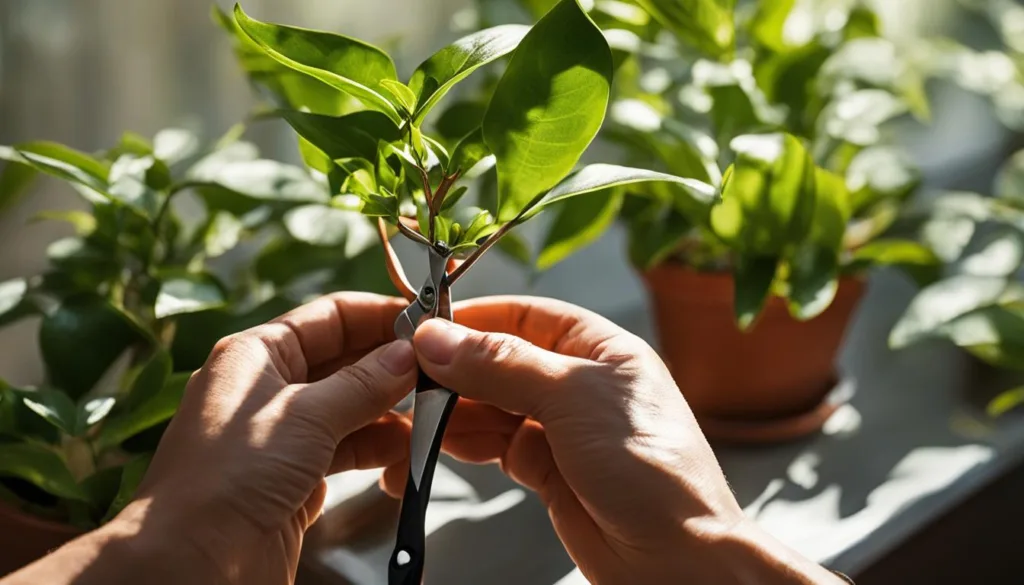
Pruning your indoor plants before you leave for vacation can help ensure their health and vitality while you’re away. Light pruning involves removing any dead or unhealthy-looking foliage, which not only improves the appearance of your plants but also promotes overall plant health.
By removing dead leaves, you prevent the spread of potential diseases or pest infestations, allowing your plants to thrive in your absence.
In addition to removing dead foliage, consider removing buds and flowers as well. While these may add visual appeal to your plants, they require more frequent watering to stay vibrant.
By removing buds and flowers before your trip, you reduce the watering needs of your plants, allowing them to conserve moisture more efficiently. This helps prevent wilting and ensures that your plants maintain their health and vigor.
Remember to use clean and sharp pruning shears to minimize damage to the plants and promote proper healing of the trimmed areas. Be mindful of the specific needs of each plant species, as some may require more or less pruning than others.
Taking the time to prune your plants before you leave will contribute to their overall well-being and make caring for them during your absence much easier.
Watering Techniques for Vacation
When it comes to ensuring the well-being of your indoor plants while you’re away on vacation, there are several watering techniques you can employ to keep them hydrated. These methods are easy to implement and can help maintain the health and vitality of your green friends.
Water Wicking Method
The water wicking method is a simple yet effective way to provide consistent moisture to your plants. To do this, you’ll need a cotton rope or string, which will act as a conduit for water to reach the plant’s roots. Place one end of the rope in a container filled with water and bury the other end into the soil of your plant. The rope will draw up water through capillary action, ensuring the plant has a steady supply of moisture.
DIY Drip System
If you prefer a more automated approach, you can create your own drip irrigation system using a drilled plastic or glass bottle. Fill the bottle with water, then carefully puncture small holes in the cap or along the sides of the bottle. Place the bottle upside down into the soil next to your plant, allowing water to slowly drip out and provide hydration. This method is especially useful for plants that require consistent moisture.
Plant Bath
Another technique you can try is giving your plants a bath before you leave. Fill your sink or bathtub with a few inches of water and place your potted plants in the water-filled basin. The plants will absorb water through their drainage holes, effectively soaking up the moisture they need. Be sure to remove your plants from the bath before you leave to avoid over-saturation.
Plastic Bag Greenhouse
If you’re looking for a way to create a mini greenhouse for your plants while you’re away, a plastic bag can do the trick. Simply cover your plant with a clear plastic bag, making sure to leave some space for air circulation. The bag will trap moisture and create a humid environment, helping to prevent dehydration. Be cautious not to seal the bag completely, as this can lead to excessive heat buildup.
| Technique | Advantages | Disadvantages |
|---|---|---|
| Water Wicking Method | – Provides consistent moisture – Easy to set up | – Requires monitoring to ensure the rope stays hydrated |
| DIY Drip System | – Automatic watering – Can be customized for individual plant needs | – Requires drilling holes in the bottle cap or sides |
| Plant Bath | – Provides thorough hydration – Easy to implement | – Can result in over-saturation if left for too long |
| Plastic Bag Greenhouse | – Creates a humid environment – Helps prevent dehydration | – Risk of excessive heat buildup if not properly ventilated |
Self-Watering Systems
When it comes to keeping your indoor plants healthy while you’re away, self-watering systems can be a game-changer. These systems provide a reliable and efficient way to ensure your plants receive the right amount of moisture even when you’re not there to water them. Here are three popular self-watering options to consider:
1. Self-Watering Planters
Self-watering planters are designed with an inner pot and reservoir system. The inner pot holds the plant and soil, while the reservoir below stores water. Through capillary action, the plant draws up water from the reservoir as needed, ensuring consistent moisture levels. This system prevents overwatering and allows the plant to take in water when it’s thirsty.
2. Inner Pot and Reservoir System
If you have existing pots that you love, you can create your own self-watering system by adding an inner pot and reservoir. This involves placing a smaller, perforated pot inside your regular pot and filling the space between them with water-absorbing material like perlite or vermiculite. The inner pot allows the plant to absorb water from the reservoir as needed, keeping it hydrated while you’re away.
3. Water-Absorbing Bulbs
Water-absorbing bulbs, also known as aqua bulbs or plant watering bulbs, are small glass or plastic bulbs that you fill with water and insert into the soil of your potted plants. As the soil dries out, the bulbs release water gradually, ensuring that your plants stay hydrated. These bulbs are a low-tech and cost-effective option for providing consistent moisture to your plants while you’re on vacation.
Using self-watering systems like these can give you peace of mind knowing that your plants are being taken care of, even when you’re not around. Whether you choose self-watering planters, create your own inner pot and reservoir system, or utilize water-absorbing bulbs, these tools can help maintain proper moisture levels and keep your plants thriving in your absence.
| Self-Watering Systems | Pros | Cons |
|---|---|---|
| Self-Watering Planters | – Consistent moisture levels – Prevents overwatering – Low maintenance | – Initial cost – Limited aesthetics |
| Inner Pot and Reservoir System | – Utilizes existing pots – Customizable to different pot sizes – Cost-effective | – Requires setup – Monitoring water levels |
| Water-Absorbing Bulbs | – Easy to use – Affordable – Suitable for small pots | – Limited water capacity – May not be suitable for larger plants |
Manage Sunlight Exposure
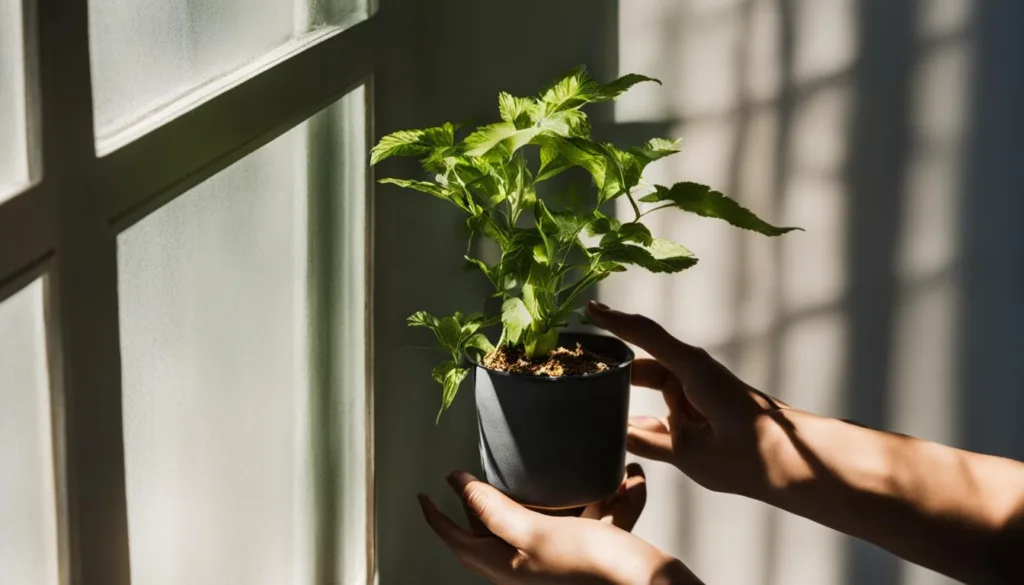
Proper sunlight exposure is crucial for the health of your indoor plants. However, too much direct sunlight can lead to drying out and wilting. To prevent this, it’s important to move your plants away from direct sunlight, especially if you’ll be away for an extended period.
One way to ensure your plants receive the optimal amount of light is by using a storage or bar cart. These portable carts allow you to easily relocate your plants to different areas of your home where they can receive the right amount of sunlight.
Using a storage or bar cart
When choosing a storage or bar cart, look for one with wheels for easy maneuverability. Place your plants on the cart and position it near a window with indirect sunlight. If the sunlight becomes too intense during the day, you can easily move the cart to a shadier spot.
By utilizing a storage or bar cart, you can ensure that your indoor plants receive the proper amount of light while you’re away, preventing them from drying out and suffering from excessive sun exposure.
| Benefits of using a storage or bar cart for plant relocation | Considerations |
|---|---|
| Easy mobility | Choose a cart with wheels for effortless movement. |
| Optimal sunlight exposure | Place the cart near a window with indirect sunlight to provide the right amount of light for your plants. |
| Protection from excessive sunlight | Easily move the cart to a shadier area if the sunlight becomes too intense. |
| Convenience | Store all your plants in one place, making it convenient to water and care for them while you’re away. |
Pre-vacation Watering and Plant Placement
Before you leave for your trip, it’s crucial to give your indoor plants the proper care and attention they need to thrive while you’re away. Here are some essential tips to ensure your plants stay healthy and happy:
First, consider using the shower watering method to thoroughly hydrate your plants before you depart. Soak the soil until the water drains out from the bottom of the pot, ensuring that you avoid over-saturating the soil. For larger plants, using a watering can with a long spout can help prevent wetting the leaves, which could lead to fungal diseases.
Along with watering, pay attention to plant placement for optimal sunlight exposure. Move your plants to areas with indirect sunlight to ensure they receive the right amount of light while you’re away. This will help prevent them from getting burnt or drying out too quickly.
If you’ll be gone for an extended period, you may want to consider using self-watering planters or water-absorbing bulbs, which can slowly release water into the soil as needed. These tools can help maintain proper moisture levels and alleviate the worry of your plants becoming parched in your absence.
After reading this, check out our other articles on:
FAQ
How can I care for my indoor plants during travel?
To care for your indoor plants while you’re away, make sure to adjust their light and temperature, maintain moisture using watering techniques, skip fertilization, do some pruning, utilize self-watering systems, manage sunlight exposure, and perform pre-vacation watering and plant placement.
How can I adjust light and temperature for my plants during travel?
Increase the distance between your plants and their light source to reduce transpiration. Avoid placing plants near air conditioning or heating systems to maintain the humidity they need.
How should I maintain moisture in my plants while I’m away?
Water your plants thoroughly before leaving for a week. For longer trips, use techniques like adding mulch or rocks to retain moisture, creating a self-watering system with capillary wicks or empty bottles, or asking a friend to water your plants for you.
Should I fertilize my plants before I leave?
It’s best to hold off on fertilization before your trip. This helps your plants grow slowly, conserve energy and water, and prevents them from becoming dependent on frequent watering.
Is it necessary to prune my plants before I travel?
Yes, it is recommended to prune off any dead or unhealthy-looking foliage before leaving. You can also remove buds and flowers as they require more frequent watering.
What watering techniques can I use while I’m on vacation?
You can use the water wicking method by placing a cotton rope between a water container and the plant’s soil, create a DIY drip system using a drilled plastic or glass bottle, give your plants a bath by placing them in a few inches of water-filled sink or bathtub, or turn a plastic bag into a makeshift greenhouse by covering the plant with it.
Are there any self-watering systems available?
Yes, you can use self-watering planters with inner pots and reservoirs to maintain proper moisture levels. Water-absorbing bulbs can also be used to slowly release water into the soil.
How can I manage sunlight exposure for my plants?
Move plants away from direct sunlight to prevent them from drying out too quickly. You can use a storage or bar cart to easily move the plants to different areas with optimal lighting conditions.
What should I do for pre-vacation watering and plant placement?
Give your plants a thorough shower watering before leaving by soaking the soil and letting excess water drain. If you have large plants, use a watering can with a long spout to avoid wetting the leaves. Consider using self-watering planters or water-absorbing bulbs for longer trips. Move plants to areas with indirect sunlight to ensure they receive the right amount of light while you’re away.

